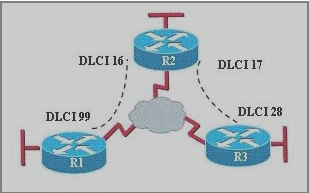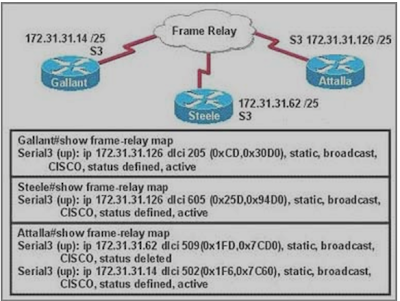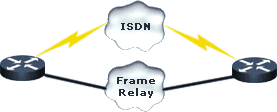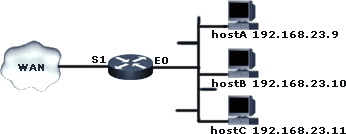640-802 WAN & Frame Relay Real Questions
Question 1:
The command frame-relay map ip 10.121.16.8 102 broadcast was entered on the router.
Which of the following statements is true concerning this command?
A: This command should be executed from the global configuration mode.
B: The IP address 10.121.16.8 is the local router port used to forward data.
C: 102 is the remote DLCI that will receive the information.
D: This command is required for all Frame Relay configurations.
E: The broadcast option allows packets, such as RIP updates, to be forwarded across the PVC.
Correct Answers: E
Question 2:
Refer to the exhibit. Which statement describes DLCI 17?
A: DLCI 17 describes the ISDN circuit between R2 and R3.
B: DLCI 17 describes a PVC on R2. It cannot be used on R3 or R1.
C: DLCI 17 is the Layer 2 address used by R2 to describe a PVC to R3.
D: DLCI 17 describes the dial-up circuit from R2 and R3 to the service provider.
Correct Answers: C
Question 3:
A default Frame Relay WAN is classified as what type of physical network?
A: point-to-point
B: broadcast multi-access
C: nonbroadcast multi-access
D: nonbroadcast multipoint
E: broadcast point-to-multipoint
Correct Answers: C
Question 4:
Which of the following are key characteristics of PPP? (Choose three.)
A: can be used over analog circuits
B: maps Layer 2 to Layer 3 address
C: encapsulates several routed protocols
D: supports IP only
E: provides error correction
Correct Answers: A C E
Question 5:
Which three Layer 2 encapsulation types would be used on a WAN rather than a LAN? (Choose three)
A: HDLC
B: Ethernet
C: Token Ring
D: PPP
E: FDDI
F: Frame Relay
Correct Answers: A D F
Question 6:
Refer to the exhibit. What is the meaning of the term dynamic as displayed in the output of the show frame-relay map command shown?
A: The Serial0/0 interface is passing traffic.
B: The DLCI 100 was dynamically allocated by the router
C: The Serial0/0 interface acquired the IP address of 172.16.3.1 from a DHCP server
D: The DLCI 100 will be dynamically changed as required to adapt to changes in the Frame Relay cloud
E: The mapping between DLCI 100 and the end station IP address 172.16.3.1 was learned through Inverse ARP
Correct Answers: E
Question 7:
Which of the following describes the roles of devices in a WAN? (Choose three.)
A: A CSU/DSU terminates a digital local loop
B: A modem terminates a digital local loop
C: A CSU/DSU terminates an analog local loop
D: A modem terminates an analog local loop
E: A router is commonly considered a DTE device
F: A router is commonly considered a DCE device
Correct Answers: A D E
Question 8:
How should a router that is being used in a Frame Relay network be configured to avoid split horizon issues from preventing routing updates?
A: Configure a separate sub-interface for each PVC with a unique DLCI and subnet assigned to the sub-interface
B: Configure each Frame Relay circuit as a point-to-point line to support multicast and broadcast traffic
C: Configure many sub-interfaces on the same subnet
D: Configure a single sub-interface to establish multiple PVC connections to multiple remote router interfaces
Correct Answers: A
Question 9:
What can a network administrator utilize by using PPP Layer 2 encapsulation? (Choose three.)
A: VLAN support
B: compression
C: authentication
D: sliding windows
E: multilink support
F: quality of service
Correct Answers: B C E
Question 10:
The Frame Relay network in the diagram is not functioning properly. What is the cause of the problem?
A: The Gallant router has the wrong LMI type configured
B: Inverse ARP is providing the wrong PVC information to the Gallant router
C: The S3 interface of the Steele router has been configured with the frame-relay encapsulation ietf command
D: The frame-relay map statement in the Attalla router for the PVC to Steele is not correct
E: The IP address on the serial interface of the Attalla router is configured incorrectly











